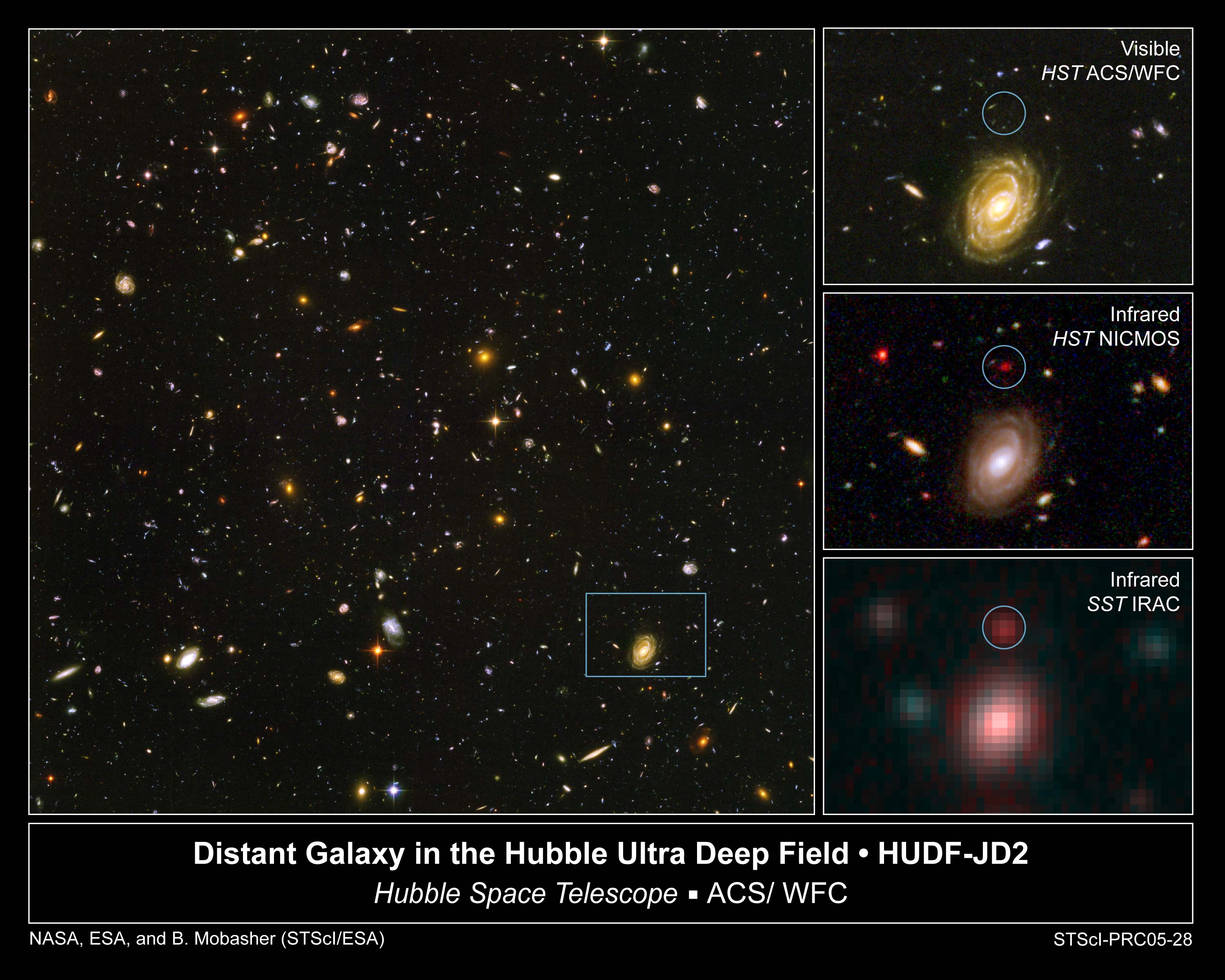|
List Of Largest Infrared Telescopes
The largest infrared telescopes for infrared astronomy are listed in terms of diameter of primary mirror. The infrared spectrum with its longer wavelength than visible light has a number of challenges, especially for ground-based observatories but also in space. Notably infrared radiation is emitted by all physical objects above Absolute Zero temperature so telescopes are subject to local interference. Overall Infrared observations from Earth's surface are possible in a limited way but can be very dependent on location and atmospheric conditions. Water vapour in the Earth's atmosphere blocks much of the infrared band, although some limited observations are possible and there is a number of infrared observatories. Sometimes other optical telescopes can make infrared observations if they are equipped with the right detectors, even if they are not dedicated infrared observatories. For ground-based observatories, the location can make a big difference in how much observation is po ... [...More Info...] [...Related Items...] OR: [Wikipedia] [Google] [Baidu] |
Atmospheric Transmission-en
An atmosphere () is a layer of gases that envelop an astronomical object, held in place by the gravity of the object. A planet retains an atmosphere when the gravity is great and the temperature of the atmosphere is low. A stellar atmosphere is the outer region of a star, which includes the layers above the opaque photosphere; stars of low temperature might have outer atmospheres containing compound molecules. The atmosphere of Earth is composed of nitrogen (78%), oxygen (21%), argon (0.9%), carbon dioxide (0.04%) and trace gases. Most organisms use oxygen for respiration; lightning and bacteria perform nitrogen fixation which produces ammonia that is used to make nucleotides and amino acids; plants, algae, and cyanobacteria use carbon dioxide for photosynthesis. The layered composition of the atmosphere minimises the harmful effects of sunlight, ultraviolet radiation, solar wind, and cosmic rays and thus protects the organisms from genetic damage. The current composition o ... [...More Info...] [...Related Items...] OR: [Wikipedia] [Google] [Baidu] |
Infrared Telescope Facility
The NASA Infrared Telescope Facility (NASA IRTF) is a telescope optimized for use in infrared astronomy and located at the Mauna Kea Observatory in Hawaii. It was first built to support the Voyager missions and is now the US national facility for infrared astronomy, providing continued support to planetary, solar neighborhood, and deep space applications. The IRTF is operated by the University of Hawaii under a cooperative agreement with NASA. According to the IRTF's time allocation rules, at least 50% of the observing time is devoted to planetary science. Telescope The IRTF is a 3.0 m (118" effective aperture) classical Cassegrain telescope. The Cassegrain focus f/ratio is f/38 and the primary mirror f/ratio is 2.5. Several aspects of the design of IRTF are optimized for IR observations. The secondary mirror is undersized to prevent the instrument from seeing the thermal emission from the telescope structure around the primary mirror. The primary mirror itself is 126" ... [...More Info...] [...Related Items...] OR: [Wikipedia] [Google] [Baidu] |
Euclid (spacecraft)
''Euclid'' is a wide-angle space telescope with a 600-megapixel camera to record visible light, a near-infrared spectrometer, and photometer, to determine the redshift of detected galaxies. It was developed by the European Space Agency (ESA) and the Euclid Consortium and was launched on 1 July 2023 from Cape Canaveral in Florida. The mission is named after the ancient Greek mathematician Euclid. After approximately one month, it reached its destination, a halo orbit around the Sun-Earth second Lagrange point L2, at an average distance of 1.5million kilometres beyond Earth's orbit. There the telescope is to remain operational for at least six years. The objective of the ''Euclid'' mission is to better understand dark energy and dark matter by accurately measuring the accelerating expansion of the universe. The Korsch-type telescope will measure the shapes of galaxies at varying distances from Earth and investigate the relationship between distance and redshift. ''Euclid'' i ... [...More Info...] [...Related Items...] OR: [Wikipedia] [Google] [Baidu] |
Wide Field Camera 3
The Wide Field Camera 3 (WFC3) is the Hubble Space Telescope's last and most technologically advanced instrument to take images in the visible spectrum. It was installed as a replacement for the Wide Field and Planetary Camera 2 during the first spacewalk of Space Shuttle mission STS-125 (Hubble Space Telescope Servicing Mission 4) on May 14, 2009. , WFC3 was still operating. Specifications The instrument is designed to be a versatile camera capable of imaging astronomical targets over a very wide wavelength range and with a large field of view. It is a fourth-generation instrument for Hubble. The instrument has two independent light paths: a UV and optical channel that uses a pair of charge-coupled devices (CCD) to record images from 200 to 1000 nm; and a near infrared detector array that covers the wavelength range from 800 to 1700 nm. The UV/optical channel has two CCDs, each 2048×4096 pixels, while the IR detector is 1024×1024. The focal planes of both chan ... [...More Info...] [...Related Items...] OR: [Wikipedia] [Google] [Baidu] |
Inch
The inch (symbol: in or prime (symbol), ) is a Units of measurement, unit of length in the imperial units, British Imperial and the United States customary units, United States customary System of measurement, systems of measurement. It is equal to yard or of a foot (unit), foot. Derived from the Uncia (unit), Roman uncia ("twelfth"), the word ''inch'' is also sometimes used to translate similar units in other measurement systems, anthropic units, usually understood as deriving from the width of the human thumb. Standards for the exact length of an inch have varied in the past, but since the adoption of the international yard during the 1950s and 1960s the inch has been based on the metric system and defined as exactly 25.4Millimetre, mm. Name The English word "inch" () was an early borrowing from Latin ' ("one-twelfth; Roman inch; Roman ounce"). The vowel change from Latin to Old English (which became Modern English ) is known as Germanic umlaut, umlaut. The consonant c ... [...More Info...] [...Related Items...] OR: [Wikipedia] [Google] [Baidu] |
Meter
The metre (or meter in US spelling; symbol: m) is the base unit of length in the International System of Units (SI). Since 2019, the metre has been defined as the length of the path travelled by light in vacuum during a time interval of of a second, where the second is defined by a hyperfine transition frequency of caesium. The metre was originally defined in 1791 by the French National Assembly as one ten-millionth of the distance from the equator to the North Pole along a great circle, so the Earth's polar circumference is approximately . In 1799, the metre was redefined in terms of a prototype metre bar. The bar used was changed in 1889, and in 1960 the metre was redefined in terms of a certain number of wavelengths of a certain emission line of krypton-86. The current definition was adopted in 1983 and modified slightly in 2002 to clarify that the metre is a measure of proper length. From 1983 until 2019, the metre was formally defined as the length of the path t ... [...More Info...] [...Related Items...] OR: [Wikipedia] [Google] [Baidu] |
HUDF-JD2
HUDF-JD2 (UDF 033238.7 -274839.8 or BBG 3179) is a distant, massive, post-starburst galaxy that was discovered with the Hubble Ultra Deep Field (HUDF) image. It was the most distant galaxy identified in the HUDF, in 2005. It is located at in the constellation of Fornax. In a 2005 search for very red galaxies in the HUDF that were not detected at wavelengths shorter than the near-infrared J band, two objects were detected. The second, initially designated UDF033238.7-274839.8, displayed a high redshift and showed characteristics of a post-starburst galaxy. The derived photometric redshift yielded ''z'' approximately equal to 6.5, which indicates it is most likely being viewed from a time when the Universe was only 830 million years old. The estimated bolometric luminosity of this galaxy is a trillion times the solar luminosity (the luminosity of the Sun) and it has a mass of approximately 600 billion solar masses. The spectrum of this object indicates that most of its energ ... [...More Info...] [...Related Items...] OR: [Wikipedia] [Google] [Baidu] |
James Webb Space Telescope Revealed (26832090085)
James may refer to: People * James (given name) * James (surname) * James (musician), aka Faruq Mahfuz Anam James, (born 1964), Bollywood musician * James, brother of Jesus * King James (other), various kings named James * Prince James (other) * Saint James (other) Places Canada * James Bay, a large body of water * James, Ontario United Kingdom * James College, a college of the University of York United States * James, Georgia, an unincorporated community * James, Iowa, an unincorporated community * James City, North Carolina * James City County, Virginia ** James City (Virginia Company) ** James City Shire * James City, Pennsylvania * St. James City, Florida Film and television * ''James'' (2005 film), a Bollywood film * ''James'' (2008 film), an Irish short film * ''James'' (2022 film), an Indian Kannada-language film * "James", a television episode of ''Adventure Time'' Music * James (band), a band from Manchester ** ''James'', US ... [...More Info...] [...Related Items...] OR: [Wikipedia] [Google] [Baidu] |
Wyoming Infrared Observatory
The Wyoming Infrared Observatory (WIRO) is an astronomical observatory owned and operated by the University of Wyoming. It is located on Jelm Mountain, southwest of Laramie, Wyoming, U.S. It was founded in 1975, and observations began at the site in 1977. Recent research performed at WIRO includes searching for runaway stars, monitoring short-term variations in blazars, and monitoring massive binary stars. Telescope The WIRO telescope is a classical Cassegrain reflector optimized for infrared observing. The secondary mirror can be "wobbled" under computer control to allow for rapid sampling of adjacent areas of the sky. From 1977 to around 1980 the telescope was the largest functional infrared telescope in the world. Two instruments are available for use: * WIRO-Prime, a 2048x2048 charge-coupled device (CCD) imaging camera mounted at the prime focus. * WIRO-Long Slit, a low resolution, high efficiency long slit spectrograph. Research and discoveries The telescope is ... [...More Info...] [...Related Items...] OR: [Wikipedia] [Google] [Baidu] |
Boeing 747
The Boeing 747 is a long-range wide-body aircraft, wide-body airliner designed and manufactured by Boeing Commercial Airplanes in the United States between 1968 and 2023. After the introduction of the Boeing 707, 707 in October 1958, Pan Am wanted a jet times its size, to reduce its seat cost by 30%. In 1965, Joe Sutter left the Boeing 737, 737 development program to design the 747. In April 1966, Pan Am ordered 25 Boeing 747-100 aircraft, and in late 1966, Pratt & Whitney agreed to develop the JT9D engine, a high-bypass turbofan. On September 30, 1968, the first 747 was rolled out of the custom-built Everett Plant, the world's List of largest buildings#Largest usable volume, largest building by volume. The 747's first flight took place on February 9, 1969, and the 747 was certified in December of that year. It entered service with Pan Am on January 22, 1970. The 747 was the first airplane called a "Jumbo Jet" as the first wide-body airliner. The 747 is a four-engined jet ... [...More Info...] [...Related Items...] OR: [Wikipedia] [Google] [Baidu] |
SOFIA ED10-0182-01 Full
Sofia is the Capital city, capital and List of cities and towns in Bulgaria, largest city of Bulgaria. It is situated in the Sofia Valley at the foot of the Vitosha mountain, in the western part of the country. The city is built west of the Iskar (river), Iskar river and has many mineral springs, such as the Sofia Central Mineral Baths. It has a humid continental climate. Known as Serdica in Classical antiquity, antiquity, Sofia has been an area of human habitation since at least 7000 BC. The recorded history of the city begins with the attestation of the conquest of Serdica by the Roman Republic in 29 BC from the Celtic settlement of Southeast Europe, Celtic tribe Serdi. During the decline of the Roman Empire, the city was raided by Huns, Visigoths, Pannonian Avars, Avars, and Slavs. In 809, Serdica was incorporated into the First Bulgarian Empire by Khan (title), Khan Krum and became known as Sredets. In 1018, the Byzantine Empire, Byzantines ended Bulgarian rule until 1194, ... [...More Info...] [...Related Items...] OR: [Wikipedia] [Google] [Baidu] |








